俄罗斯全面中英文介绍共35页文档
- 格式:ppt
- 大小:4.15 MB
- 文档页数:35
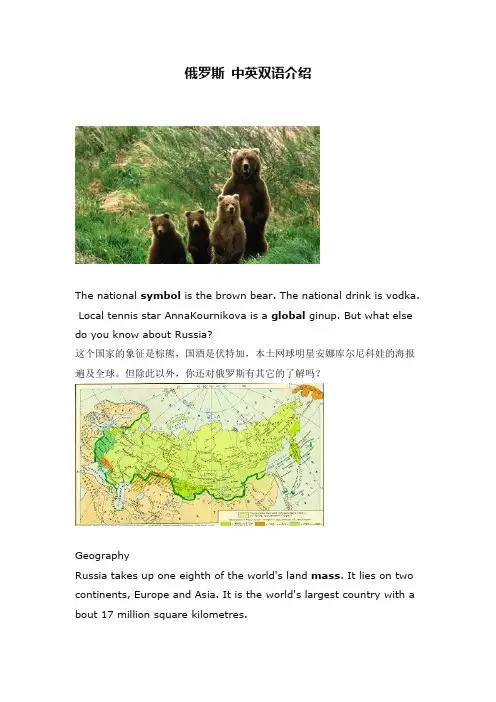
俄罗斯中英双语介绍The national symbol is the brown bear. The national drink is vodka. Local tennis star AnnaKournikova is a global ginup. But what else do you know about Russia?这个国家的象征是棕熊,国酒是伏特加,本土网球明星安娜库尔尼科娃的海报遍及全球。
但除此以外,你还对俄罗斯有其它的了解吗?GeographyRussia takes up one eighth of the world's land mass. It lies on two continents, Europe and Asia. It is the world's largest country with a bout 17 million square kilometres.地理俄罗斯占世界陆地面积的1/8,地跨欧亚两大陆。
它的面积约有1700万平方公里,是世界上领土最大的国家。
Onion DomesMoscow postcards typically feature the colourful striped domes of St . Basil's Cathedral and theneighboring Red Square. St. Basil's was b uilt between 1555 and 1561. Other Russian churchesalso have flam e-shaped domes. The dome's peak is said to be like the flame of pra yer reaching up toward heaven. The cross at the top symbolizes Chri st.洋葱型屋顶典型的莫斯科明信片上的风光图就是圣瓦西里大教堂彩色条纹圆屋顶和相邻的红场。

俄罗斯介绍简介下载提示:该文档是本店铺精心编写而成的,如果您有需求,可以下载,希望能够帮您解决问题。
文档下载后还可以定制修改,根据大家的实际需要进行调整和使用。
谢谢!本店铺为大家提供各种类型的实用资料,比如工作总结、文案摘录、教育随笔、日记赏析、句子摘抄、古诗大全、经典美文、话题作文等等,如您想了解不同资料格式和写法,敬请关注后续跟新内容! Download tip: this document is carefully written by this store, if you have needs, you can download it, I hope to help you solve the problem. After downloading, the document can also be customizedand modified, and adjusted and used according to everyone's actual needs.thanks! This store provides you with a variety of types of practical information, such as work summary, copy excerpts, education essays, diary appreciation, sentence excerpts, ancient poetry, classical essays, topic composition and so on, if you want to know different data formats and writing methods, please pay attention to the follow-up with the new content!俄罗斯,位于欧亚大陆东部,是世界上最大的国家,其独特的地理位置和悠久的历史使其成为一个备受关注的国家。

史上最全俄罗斯中英双语介绍、HistoryFormerly the dominant republic of the Union of Soviet Socialist Republics (USSR), Russia is now an independent country, and an influential member of the Commonwealth of Independent States, since the union’s dissolution in December 1991. During the Soviet era, Russia was officially called the Russian Soviet Federated Socialist Republic (RSFSR). Russia is usually considered the Soviet Union’s successor state in diplomatic matters.Russia was founded in the 12th century as the Principality of Muscovy. It was able to emerge from over 200 years of Mongol domination (13th-15th centuries) and to gradually conquer and absorb surrounding principalities. In the early 17th century, a new Romanov Dynasty continued this policy of expansion across Siberia to the Pacific. Under Peter I (ruled 1682-1725), hegemony was extended to the Baltic Sea and the country was renamed the Russian Empire. During the 19th century, more territorial acquisitions were made in Europe and Asia. Repeated devastating defeats of the Russian army in World War I led to widespread rioting in the major cities of the Russian Empire and to the overthrow in 1917 of the imperial household.The Communists under Vladimir Lenin seized power soon after and formed the USSR. Josef Stalin (1928-53) strengthened Russian dominance of the Soviet Union.The Soviet Union consolidated its hold on Eastern Europe and sought to expand its influence elsewhere in the world. This active foreign policy helped bring about the Cold War, which turned the Soviet Union’s wartime allies, the United Kingdom and the United States, into foes.Stalin died in 1953 and in the absence of an acceptable successor, the Soviet economy and society stagnated in the following decades until General Secretary Mikhail Gorbachev (1985-91) introduced glasnost (openness) and perestroika (restructuring) in an attempt to modernize Communism. However, his initiatives inadvertently released forces that by December 1991 splintered the USSR into 15 independent republics. Since then, Russia has struggled in its efforts to build a democratic political system and market economy to replace the strict social, political, and economic controls of the Communist period.Most of the area, population, and industrial production of the Soviet Union, then one of the world’s two superpowers, lay in Russia. After the breakup of the USSR, Russia’s global role however has greatly diminished, and cannot be compared to that of the former Soviet Union.历史俄罗斯是前苏联社会主义共和国的主要国家,现在是一个独立国家,自从1991年苏联解体后它是独立的联邦政府中最有影响的成员。
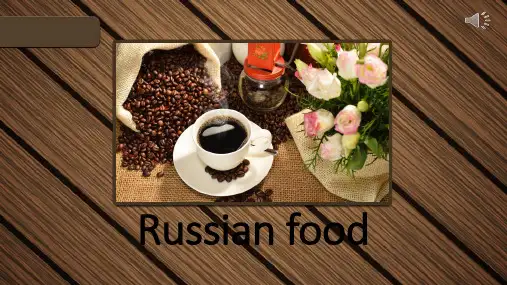
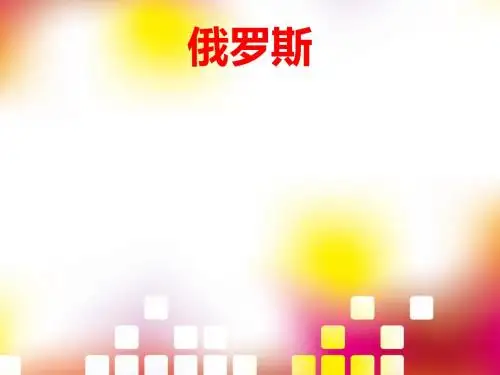
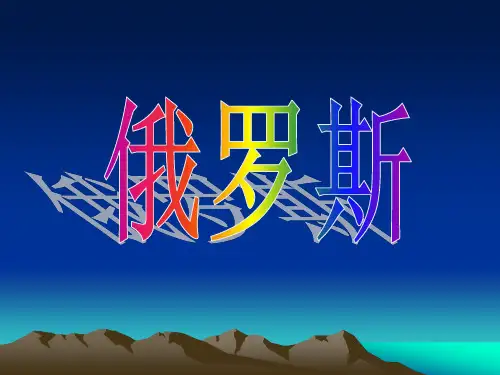

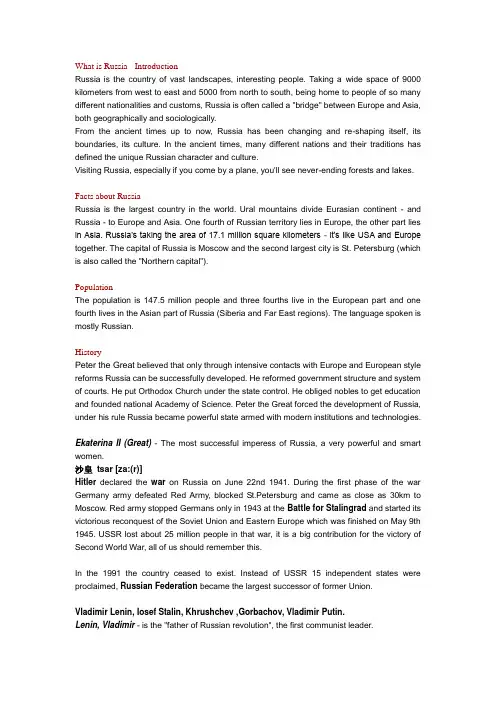
What is Russia - IntroductionRussia is the country of vast landscapes, interesting people. Taking a wide space of 9000 kilometers from west to east and 5000 from north to south, being home to people of so many different nationalities and customs, Russia is often called a "bridge" between Europe and Asia, both geographically and sociologically.From the ancient times up to now, Russia has been changing and re-shaping itself, its boundaries, its culture. In the ancient times, many different nations and their traditions has defined the unique Russian character and culture.Visiting Russia, especially if you come by a plane, you'll see never-ending forests and lakes.Facts about RussiaRussia is the largest country in the world. Ural mountains divide Eurasian continent - and Russia - to Europe and Asia. One fourth of Russian territory lies in Europe, the other part lies in Asia. Russia’s taking the area of 17.1 million square kilometers - it’s like USA and Europe together. The capital of Russia is Moscow and the second largest city is St. Petersburg (which is also called the "Northern capital").PopulationThe population is 147.5 million people and three fourths live in the European part and one fourth lives in the Asian part of Russia (Siberia and Far East regions). The language spoken is mostly Russian.HistoryPeter the Great believed that only through intensive contacts with Europe and European style reforms Russia can be successfully developed. He reformed government structure and system of courts. He put Orthodox Church under the state control. He obliged nobles to get education and founded national Academy of Science. Peter the Great forced the development of Russia, under his rule Russia became powerful state armed with modern institutions and technologies.Ekaterina II (Great) - The most successful imperess of Russia, a very powerful and smart women.沙皇tsar [za:(r)]Hitler declared the war on Russia on June 22nd 1941. During the first phase of the war Germany army defeated Red Army, blocked St.Petersburg and came as close as 30km to Moscow. Red army stopped Germans only in 1943 at the Battle for Stalingrad and started its victorious reconquest of the Soviet Union and Eastern Europe which was finished on May 9th 1945. USSR lost about 25 million people in that war, it is a big contribution for the victory of Second World War, all of us should remember this.In the 1991 the country ceased to exist. Instead of USSR 15 independent states were proclaimed, Russian Federation became the largest successor of former Union.Vladimir Lenin, Iosef Stalin, Khrushchev ,Gorbachov, Vladimir Putin.Lenin, Vladimir - is the "father of Russian revolution", the first communist leader.Eltsin, Boris - the first President of the Russian Federation, who was died in April of this year. Putin, Vladimir - the second President of the Russian FederationWhy Vladimir use Lenin as his nickname?Putin—song? Smoking, drinking, family violence, three big social crisis.MoscowMoscow, capital and largest city of Russia, and the country’s leading political, cultura l, economic, and transportation center. Moscow lies on the Moscow River in the west central European part of Russia.Moscow has matured over a millennium into a richly layered, ever-expanding, and never-sleeping metropolis. Its sporadic growth has left it without a compact downtown, which means that great sights, hotels, and restaurants can be found in nearly any corner of the city. Its vast territory requires a good bit of walking and plenty of rides via metro (subway), taxi, or tour bus.Moscow has a continental climate, with long, cold winters and short, mild summers.。
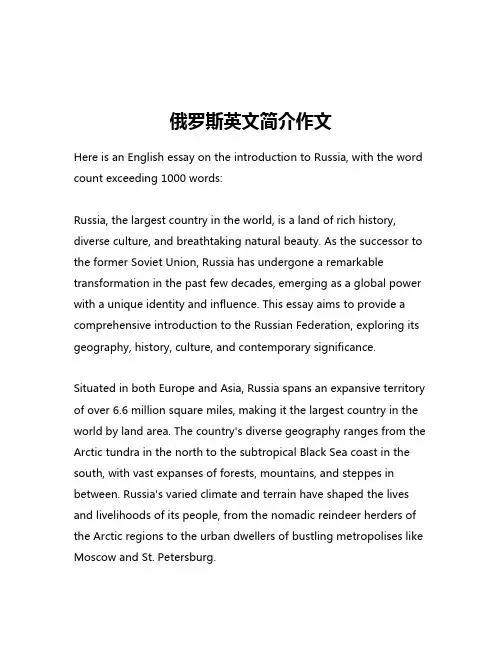
俄罗斯英文简介作文Here is an English essay on the introduction to Russia, with the word count exceeding 1000 words:Russia, the largest country in the world, is a land of rich history, diverse culture, and breathtaking natural beauty. As the successor to the former Soviet Union, Russia has undergone a remarkable transformation in the past few decades, emerging as a global power with a unique identity and influence. This essay aims to provide a comprehensive introduction to the Russian Federation, exploring its geography, history, culture, and contemporary significance.Situated in both Europe and Asia, Russia spans an expansive territory of over 6.6 million square miles, making it the largest country in the world by land area. The country's diverse geography ranges from the Arctic tundra in the north to the subtropical Black Sea coast in the south, with vast expanses of forests, mountains, and steppes in between. Russia's varied climate and terrain have shaped the lives and livelihoods of its people, from the nomadic reindeer herders of the Arctic regions to the urban dwellers of bustling metropolises like Moscow and St. Petersburg.Russia's history is a tapestry of conquests, revolutions, and cultural rejuvenation. The origins of the Russian state can be traced back to the Kievan Rus, a medieval Slavic civilization that emerged in the 9th century. Over the centuries, the Russian Empire grew to become one of the largest and most powerful empires in the world, spanning from the Baltic Sea to the Pacific Ocean. The 20th century saw the rise and fall of the Soviet Union, a communist superpower that left an indelible mark on global politics and the lives of its citizens.The collapse of the Soviet Union in 1991 ushered in a new era for Russia, as the country transitioned from a centralized, communist system to a market-based economy and a more democratic political structure. While the transition has been challenging, with periods of political and economic instability, Russia has emerged as a major player on the world stage, wielding significant influence in areas such as energy, diplomacy, and military might.Russia's cultural heritage is equally rich and diverse, drawing from the traditions of its many ethnic groups and regions. The country is renowned for its world-class literature, with authors such as Fyodor Dostoevsky, Leo Tolstoy, and Alexander Pushkin leaving an indelible mark on world literature. Russian art, music, and architecture have also made significant contributions to the global cultural landscape, with the Bolshoi Ballet, the works of Pyotr Tchaikovsky, and the iconic onion-domed churches of Moscow being just a few examples.In the realm of science and technology, Russia has a long and proud history of groundbreaking discoveries and innovations. From the pioneering space exploration efforts of the Soviet era to the cutting-edge advancements in fields like nuclear energy and cybersecurity, Russia has consistently demonstrated its scientific and technological prowess.Today, Russia continues to play a crucial role on the global stage, both as a major economic and political power. The country's vast natural resources, particularly its oil and natural gas reserves, have made it a key player in the international energy market. Russia's permanent seat on the United Nations Security Council and its membership in organizations like the G8 and the Shanghai Cooperation Organization give it a significant voice in global affairs.At the same time, Russia has faced a range of challenges in recent years, including economic sanctions, tensions with the West, and internal political and social upheavals. The country's authoritarian tendencies, human rights record, and foreign policy actions have drawn criticism from the international community, but Russia remains a complex and influential player on the world stage.In conclusion, Russia is a multifaceted and dynamic country, with a rich history, diverse culture, and significant global influence. From itsvast and varied geography to its complex political and social landscape, Russia continues to captivate and intrigue people around the world. As the country navigates the challenges and opportunities of the 21st century, its story will undoubtedly continue to evolve, leaving a lasting impact on the global community.。

介绍俄罗斯英文对话作文英文回答:Russia is a vast and diverse country with a richhistory and culture. It is the largest country in the world, spanning 11 time zones and covering over 17 million square kilometers. Russia is home to a wide variety of landscapes, from the frozen tundra of the Arctic to the subtropical forests of the Caucasus Mountains. The country is also home to a diverse population of over 140 million people, representing over 100 different ethnic groups.I have had the opportunity to visit Russia on several occasions, and I have always been impressed by the beautyof the country and the warmth of its people. I have visited Moscow, the capital of Russia, and St. Petersburg, the former imperial capital. I have also traveled to Siberiaand the Ural Mountains. Each region of Russia has its own unique charm and beauty.One of the things that I love most about Russia is its people. Russians are known for their hospitality and their love of life. They are always willing to help a stranger, and they are always up for a good time. I have made many friends in Russia, and I always look forward to seeing them again.Another thing that I love about Russia is its culture. Russia has a rich history of art, music, and literature. The country is home to some of the world's most famous museums, theaters, and concert halls. I have had the opportunity to see some of the world's greatest works ofart in Russia, and I have heard some of the world's greatest musicians perform.Russia is a country that has something to offer everyone. Whether you are interested in history, culture, or nature, you will find something to love in Russia. I highly recommend visiting Russia if you have the opportunity. It is a truly amazing country.中文回答:俄罗斯是一个历史悠久、文化底蕴深厚的国家。
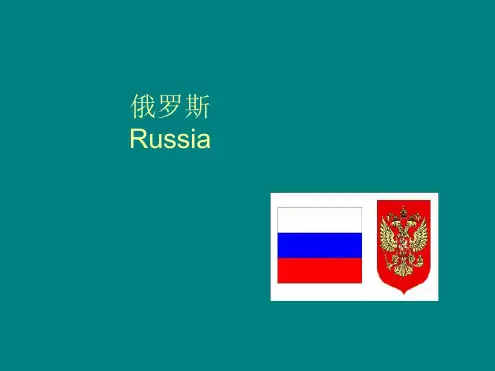
俄罗斯英文简介Russia is the biggest country on Earth. Russia is so big that the whole United States could fit inside it nearly twice. In fact, if you started from one end of Russia, you would travel almost halfway around the world before you reached the other end!Russia extends across two continents. About one-third of it lies in Europe. The rest stretches all the way across northern Asia. The Ural Mountains, which run north to south, divide European Russia from Asian Russia. In all, about 141 million people live in Russia.Russia’s weather is a lot like that of Canada—the world’s second biggest country in area. Russia lies about as far north as Canada. The weather tends to be cold, with long winters and short summers.Facts About RussiaOfficial name Russian FederationCapital MoscowOfficial language RussianPopulation 141,000,000 peopleRank among countries inpopulation8thMajor cities Moscow, St. Petersburg, Nizhniy NovgorodArea 6,590,000 square miles17,100,000 square kilometersRank among countries in area 1stHighest point Elbrus18,510 feet/5,642 metersCurrency RubleEUROPEAN RUSSIAA great plain stretches over European Russia. Slow-moving rivers crisscross this plain, including the Volga, the Daugava, and the Don. Most Russians live in this part of the country.In the north, many swamps and lakes dot the plain. In the south, the rich soils make good farmland.MOSCOW AND SAINT PETERSBURGMore than ten cities in European Russia have over 1 million people, but the largest by far is Moscow, Russia’s capital. Moscow grew up on the banks of the Moscow River. Today, it is a city of more than 10 million people.At the heart of Moscow is a famous old fortress called the Kremlin. Today, the Kremlin is the seat of the Russian government. At the foot of the Kremlin’s eastern walls is Red Square, a vast public square that has been the scene of many famous events in Russian history. On the south end of Red Square is Saint Basil’s Cathedral. The cath edral’s multicolored, onion-shaped domes are world-famous.The next largest city is Saint Petersburg, Russia’s biggest seaport. Saint Petersburg is on the Gulf of Finland to the west. Its lavish palaces and grand cathedrals make it one of Europe’s most beautiful cities. For more than two centuries, from 1712 to 1918, Saint Petersburg was Russia’s capital.ASIAN RUSSIAThe Asian part of Russia is called Siberia. It lies to the east of the Ural Mountains. Siberia is a treasure-trove of natural resources. It has huge deposits of oil, natural gas, and minerals, and vast stands of timber.FROZEN TUNDRAThe northernmost part of Siberia has treeless plains, calledtundra. Most of the tundra is covered by permafrost, a deeply frozen soil. Few plants can grow in this part of Siberia.Ice on the surface melts in summer, but th e warmth can’t sink through the frozen soil. So the water pools in great marshes that swarm with flies and mosquitoes. Polar bears, walruses, and reindeer live on this land.VAST FORESTSSouth of the tundra is a great belt of forested land called taiga. Russia contains about one-quarter of the world’s forested area. Sable, lynx, wolves, and brown bears live here. In Siberia’s eastern forests live antelope, leopards, and the world’s biggest cats—Siberian tigers.THE STEPPESRolling grasslands, called steppes, cover much of southern Siberia. Siberia’s richest farmland is found here. Today, the steppes have been plowed and planted for farming.RISE OF THE RUSSIAN TSARSDuring the 1400s, the princes of Moscow began wars to conquer lands around Russia. They called themselves tsars, a title Russians once used for their own conquerors. One Russian tsar, Peter the Great, decided to make his country like the ones found elsewhere in Europe.When Peter came to power in the late 1600s, Russia was a backward land. Farming was primitive. The military was poorly organized. Peter ordered his nobles to dress like other Europeans. He built a strong army, roads, and canals. Russian tsars became powerful European kings.RUSSIAN CULTURE BLOOMSThe arts flourished in Russia during the 1800s. Writers such as Leo Tolstoy, Fyodor Dostoyevsky, and Anton Chekhov pennedgreat works of literature. Musicians such as Peter Tchaikovsky and NikolayRimsky-Korsakov composed influential music. Russians performed brilliant ballets and operas.SEEDS OF COMMUNISMBy the late 1800s, many Russians began to oppose the great power of the tsars. Most Russians were poor farmers called serfs. Serfs were not allowed to leave the land where they worked. Many other Russians were terribly poor factory workers. Among these workers, an idea called Communism took hold.Communists said that all workers should own the land and factories and control the government. In 1917, a Communist movement, led by Vladimir Lenin, seized power.THE COMMUNIST ERAIn 1922, after a civil war, the Communists created a new state. They called it the Union of Soviet Socialist Republics (USSR, or Soviet Union, for short). Russia was the biggest part of this new state.After Lenin died, Joseph Stalin took his place. Stalin turned Russia into a Communist country by force. He killed many people and sent millions moreto prison camps in Siberia. His secret police, the KGB, terrorized the Russian people.During World War II, the Soviet Union helped defeat Germany. After the war ended in 1945, the Soviet Union took control of the countries in Eastern Europe.COMMUNISM LOSES STEAMBy 1989, Russians had grown tired of Communism. The system could not produce enough ordinary goods, such as clothing or cars. Soviet leader Mikhail Gorbachev tried to loosenthe system. But his changes allowed the people to sweep the Communists out altogether.In December 1991, the Soviet Union officially ended. The different parts of the Soviet Union became separate countries again, including Russia. LIFE IN RUSSIA TODAYSince then, Russia has inched toward democracy. The government no longer tries to control every aspect of Russian life, as it once did. An elected president now leads the country. Factories have been sold to private companies. Land has been given to private citizens and businesses.。
俄罗斯英文介绍小学生作文下载温馨提示:该文档是我店铺精心编制而成,希望大家下载以后,能够帮助大家解决实际的问题。
文档下载后可定制随意修改,请根据实际需要进行相应的调整和使用,谢谢!并且,本店铺为大家提供各种各样类型的实用资料,如教育随笔、日记赏析、句子摘抄、古诗大全、经典美文、话题作文、工作总结、词语解析、文案摘录、其他资料等等,如想了解不同资料格式和写法,敬请关注!Download tips: This document is carefully compiled by theeditor. I hope that after you download them,they can help yousolve practical problems. The document can be customized andmodified after downloading,please adjust and use it according toactual needs, thank you!In addition, our shop provides you with various types ofpractical materials,such as educational essays, diaryappreciation,sentence excerpts,ancient poems,classic articles,topic composition,work summary,word parsing,copyexcerpts,other materials and so on,want to know different data formats andwriting methods,please pay attention!I am going to introduce you to a group of young students from Russia. These kids are full of energy and enthusiasm, always ready to explore and learn new things. They are the future of Russia and are determined to make a difference in the world.Let me tell you about their school. It is a vibrant place, filled with laughter and excitement. The classrooms are colorful and inviting, with walls covered in artwork created by the students themselves. The teachers are passionate about their work and go above and beyond to ensure that every child receives a quality education.In this school, learning is not limited to textbooks and exams. The students have the opportunity to participate in a wide range of extracurricular activities. Some of them are part of the school choir, while others enjoy playing sports like football or basketball. There are also clubsfor art, science, and even coding. These activities helpthe students develop their talents and interests outside of the traditional classroom setting.The students in this school are not only focused on their own growth but also on making a positive impact on their community. They regularly participate in community service projects, such as cleaning up local parks or organizing fundraisers for those in need. These experiences teach them the value of compassion and empathy, and they understand the importance of giving back to society.One unique aspect of this school is its emphasis on cultural diversity. Russia is a vast country with a rich history and diverse population, and the students are encouraged to celebrate and embrace this diversity. They learn about different cultures, traditions, and languages, fostering an environment of respect and understanding.Despite their young age, these students are already thinking about their future careers. They dream of becoming doctors, engineers, artists, and even astronauts. The school provides them with the necessary resources andguidance to pursue their dreams, encouraging them to think big and never give up.In conclusion, these young students from Russia are full of potential and determination. They are eager to learn, explore, and make a difference in the world. With their diverse talents and passion for learning, they are sure to achieve great things in the future.。
世界各国介绍-俄罗斯(欧洲篇)俄罗斯简介俄罗斯联邦,简称俄罗斯,横跨欧亚大陆,与中国、朝鲜、哈萨克斯坦、蒙古、格鲁吉亚、阿塞拜疆、乌克兰、芬兰、白俄罗斯、爱沙尼亚、拉脱维亚和挪威、波兰、立陶宛总共14个国家接壤,总面海岸线长达38807千米,由85个联邦主体组成。
俄罗斯是一个多民族国家,总共有194个民族,其中俄罗斯族占总人口的77.7%。
俄罗斯国旗首都:莫斯科国庆日:1990年6月12日国歌:《俄罗斯国歌》官方语言:俄语货币:俄罗斯卢布国土面积:1709.82万km²人口数量:1.46亿人口密度:8.8人/平方公里自然资源俄罗斯幅员辽阔,自然资源丰富。
主要矿产资源有,石油、天然气、煤、铁矿石等,其他矿产资源也蕴藏丰富。
储量占世界前三名的矿产资源多达十余种。
是世界第一资源大国。
森林覆盖率达到国土面积的51%,储量达820亿立方米,稳居世界第一。
大小河流和胡泊加起来达到500万个。
水利资源蕴藏量丰富。
渔业资源就更不用说了,看看其海岸线的长度,就知道俄罗斯渔业资源是什么情况。
俄罗斯拥有大片平坦的土地,土地肥沃。
特别适合农作物的生长和机械化的大面积作业。
农业条件十分优越,因此,有我们很多中国人去俄罗斯承包土地,搞种植。
俄罗斯历史俄罗斯从15世纪末到16世纪末,逐渐形成了一个封建国家。
1721年,彼得一世(彼得大帝)时期,正式形成俄罗斯帝国。
彼得一世,为俄罗斯的崛起,做出了巨大贡献。
他改革利弊,学习西方先进的技术,建立了俄国的第一支舰队。
俄罗斯的近代发展史,无论政治、经济、文化,都起源于彼得一世时期。
是被俄罗斯人承认的两个“大帝”之一。
叶卡捷琳娜大帝叶卡捷琳娜大帝(剧照)叶卡捷琳娜其实是一名德国人,但不能阻挡她成为俄罗斯的两个“大帝”之一。
1745年,叶卡捷琳娜来到俄罗斯,与皇位继承人彼得三世结为夫妻,改名为叶卡捷琳娜。
1762年,叶卡捷琳娜发动军事政变,取代彼得三世,成为俄罗斯女皇。
叶卡捷琳娜,政治眼光开明,军事才能卓越,虽然不能带兵打仗,但是善于点将,在位期间,她东张西扩,为俄罗斯打下了60万平方公里的疆土。